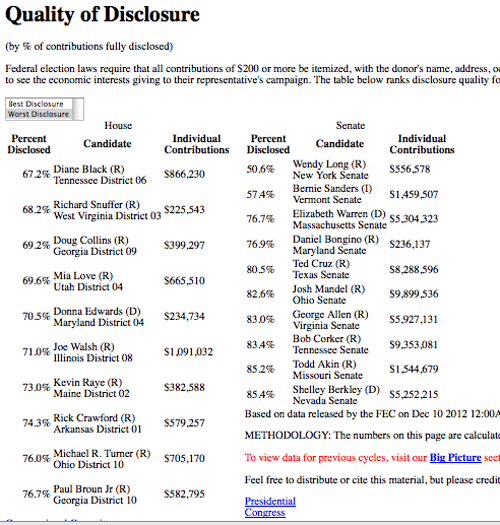It seemed like a startling and politically powerful story. I was looking through campaign finance disclosures, and came upon a striking chart compiled by the respected watchdog group Center for Responsive Politics. The graphic ranked US Senators based on how fully they had disclosed required information about high dollar donors to their 2012 campaigns.
The two least transparent members of the upcoming Senate, it appeared, were its fiercest critics of shadowy political largesse by the 1 percent: Bernie Sanders and Elizabeth Warren.
But when I followed up, what appeared to be a story about political hypocrisy quickly turned into something else.
My reporting began with a chart on OpenSecrets.org, the Center for Responsive Politics’ website, that measured “quality of disclosure” by Congressional candidates. Candidates are supposed to tell the Federal Election Commission the occupation and employer of contributors of over $200—crucial information for understanding the firms and industries that are financing members’ campaigns. The rumpled socialist Sanders, and the scourge of Wall Street Warren, appeared to be revealing the least about the economic interests behind their candidacies. Here is the chart (click to enlarge):

|
I called the Center for Responsive Politics, where director Sheila Krumholz reviewed the Center’s methodology but did not have an explanation for the two Senators’ low rates of disclosure. “As for Warren or Sanders, I really am a loss to explain why they would not have higher percentage disclosure,” Krumholz said.
When I called the Senators’ offices, the story quickly unraveled. The Sanders campaign’s finance director, Ben Eisenberg, called me back to say he had examined contribution records and suggested an explanation. He said his review had found retirees that were not being counted as having properly disclosed their occupation and employers. Sanders’ apparently secretive donors, he said, were in fact elderly retirees.
The Warren campaign sent an article from a Massachusetts newspaper, the Patriot Ledger, in which reporter Corey Kane had done his own analysis of Warren’s original filings with the FEC through the middle of August. He found that Warren had disclosed the employment information of a sterling 98 percent of her contributors.
The next day, when I called back the Center for Responsive Politics, they reviewed their statistics again. They found that they had made a mistake: an error in updating their databases had deleted the employment and occupation fields for many contributions (a problem that included but was not limited to retirees). Krumholz, the CRP director, said the error had only affected their “quality of disclosure” data and not their candidate and industry profiles more broadly.
“The acceptable error rate is zero,” Krumholz said, “but we’re human.”
There are a couple of obvious takeaways here. The most accessible and user-friendly data is often from secondhand sources, and their statistics and analysis are worth checking up on—when possible, review primary documents. And, if you’re working on a negative story, it’s usually wise to give the subject a call.
Finally, findings that are counterintuitive deserve an extra bit of scrutiny. Sanders’ and Warren’s vociferous support for campaign finance reform and curbing the political power of elites are all the more reason to check up on their individual records of disclosure. But when they appear to be falling down on the job—and especially when there is no clear explanation for it—it’s a good reason to double check before publishing.
Sasha Chavkin is an investigative reporter specializing in the environment, Latin America, and public corruption. He was the lead reporter for OCCRP's "Nicaragua's Forgotten Deforestation Crisis" investigation, and is currently a 2021-22 Ted Scripps Fellow in Environmental Journalism at the University of Colorado at Boulder.
